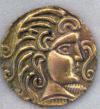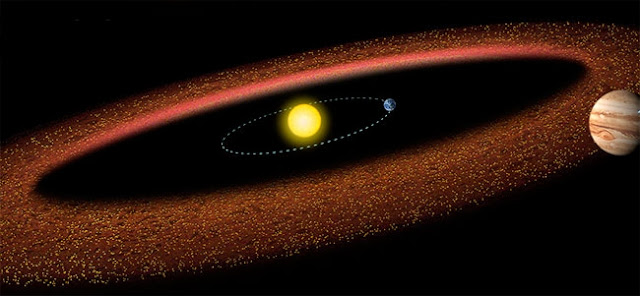

| Online: | |
| Visits: | |
| Stories: |

| Story Views | |
| Now: | |
| Last Hour: | |
| Last 24 Hours: | |
| Total: | |
New Model for Asteroid Belt Formation
Ceres is the largest object of the so-called asteroid belt, but is far from the only one. It is estimated that the belt is made up of more than 1 million of them. For more than 200 years astronomers have tried to find out how the asteroid belt formed and why there is no planet between Mars and Jupiter.
Despite the huge amount of data gathered over two centuries of belt research – including thanks to several space probes that have been sent there – no consensus has yet been reached on how it would have formed.Researchers at Unesp publish an article in The Astrophysical Journal suggesting that asteroids between the orbits of Mars and Jupiter are evidence of a chaotic solar phase in the solar system
New cases continue to be made, as is the model called “chaotic”, recently described in The Astrophysical Journal . Its authors are Brazilian astronomers André Izidoro and Othon Winter, from the Orbital and Planetology Dynamics Group of the Universidade Estadual Paulista (Unesp), Guaratinguetá campus, in collaboration with colleagues from France and the United States. The work was supported by FAPESP in the Thematic Project and Support to Young Researchers modalities .
The planets of the Solar System are divided into two categories, the rocky or terrestrial (Mercury, Venus, Earth and Mars), which are in the inner Solar System, and the gaseous giants (Jupiter, Saturn, Uranus and Neptune) of the outer Solar System.
Between the two groups is the main asteroid belt. Its hundreds of thousands of objects span a wide orbital range from approximately 1.8 to 3.2 astronomical units of the Sun (an astronomical unit is the average distance from the Sun to the Earth).
“Gaseous giants such as Jupiter and Saturn were the first to form when the Solar System had a maximum of 10 million years,” said Izidoro, whose research ” Planetary Formation and Dynamics: From the Solar System to the Exoplanets ” has support Of FAPESP through the Young Researchers Program in Emerging Centers.
According to him, the gaseous giants formed from the accretion, that is, the accumulation of gas from the solar nebula that enveloped the solar system. This same gas is part of the one that served as raw material for the formation and ignition of the Sun.
The Earth formed when there was no more gas available, for all matter in the nebula had been swallowed up by the sun or by the gaseous giants, and whatever had not been dissipated or expelled far away by the intense radiation of the newborn sun. “It is estimated that the Earth formed when the Sun was between 30 and 150 million years old. The asteroid belt formed earlier than Earth, but the asteroids only reached the current distribution throughout the history of the Solar System, “said Izidoro.
“To explain the Chaotic model we must first talk about the main current model of formation of the Solar System, the Grand Tack,” said Izidoro. The name of this theory is inspired by a nautical maneuver called “gang” or “gang for tack” ( tacking , in English), which is to change the direction of a boat putting the bow into the wind.
By the Grand Tack model, during the formation of Jupiter, the planet would have migrated from its original orbit to 3.5 astronomical units of the Sun to about 1.5. However, just as it had migrated close to the Sun, the planet Jupiter then went the other way. This happened thanks to Saturn, the second largest planet in the Solar System.
As Saturn incorporated gas and grew, it also migrated toward the Sun. Jupiter and Saturn would have given a “bump” as Saturn encountered Jupiter on the way to approaching the Sun.
This round-trip movement of Jupiter and Saturn, according to the Grand Tack, had two consequences: one for Mars and the other for the formation of the asteroid belt.
In the Martian case, the planetary “cleaner” in which Jupiter (and Saturn) had converted removed most of the available feedstock from the orbit of Mars to the asteroid belt. That is why Mars, when it was formed later, would accumulate enough material to reach only a tenth of the mass of the Earth.
Already in the case of the asteroid belt, the gravitational influence of Jupiter brought more drastic consequences. Only a small fraction of the original material survived in the region of the asteroid belt, an amount insufficient to form a planet, but consistent with what is observed today. In addition, the distribution of asteroids in this model is very similar to that of real asteroids.
Computer simulation
By observing the nebulae of solar protossystems in the Milky Way, astronomers can check the conditions by which giant planets form.
“The Grand Tack is very accepted, very solid and supported by astronomical observations. But that is not to say that it is correct, nor that the asteroid belt has formed in the way that it predicts, “said Izidoro.
Winter agrees. “The Grand Tack is not the only model to explain the formation of the asteroid belt. Our Chaotic model is also feasible, “said the professor of the Department of Mathematics at the Faculty of Engineering of Unesp, coordinator of the Thematic Project” Orbital Dynamics of Small Bodies “.
The difference between the two models is based on a basic variable: the amount of raw material available in the Mars region and the asteroid belt. The Grand Tack assumes that there was a lot of material in these regions and that this matter was removed by Jupiter and Saturn during a dramatic phase of migration.
Already the Chaotic model developed by Izidoro and Winter starts from the premise that there was almost no matter in those regions. This hypothesis dispenses with an intense migration of Jupiter towards the Sun, since it assumes at the outset that there was almost no matter there.
Astronomical studies are conducted both from astronomical observations and from computational simulations. The latter are done by compiling and running programs that simulate the behavior of the celestial bodies that one wants to study according to the physical laws and variables that one wants to test.
“In astronomical studies, dozens or even hundreds of different simulations are performed. “However, they all provided unsatisfactory results, which did not replicate a Solar System as we have seen. All but one. “
The only positive result of the Chaotic model, the one that matches the Solar System we observed, was obtained by chance. This happened when, in the simulation variables, the orbits of Jupiter and Saturn were slightly altered, but kept in the same resonance.
Two planets are in resonance when their orbits are synchronized at the ratio of integers such as 1, 2, 3, 4, etc. In this particular case, the configuration was such that for each orbit of Saturn, Jupiter described, but not exactly, two complete turns around the Sun. The simulation provided for a small vibration in the orbits of Jupiter and Saturn.
“The vibration was minimal, unable to remove the planets from the resonant state, but sufficient to alter the balance of the system. That’s when the chaos that gave the model its name emerged, “said Winter.
Instead of the simulation calculating the orbits of Jupiter and Saturn as perfect ellipses, the planets would describe orbits minimally different from each other, both in the shape of the ellipse and in its oscillation relative to the plane of the Solar System. This minimum condition was enough to change all the behavior of the asteroids in the main belt.
“The difference between the result of this simulation where Jupiter and Saturn had chaotic orbits and those where they did not was really impressive,” Izidoro said.
“The simulation resulted in an inner solar system with small Mars, with mass equivalent to what it actually has, and an asteroid belt with a distribution of bodies very similar to that observed. In our model, asteroid distribution reached its current status sometime during the solar system’s infancy, that is, during its first 700 million years, “said Izidoro.
“In the Chaotic model, Jupiter and Saturn probably migrated a little toward the Sun, but at a much lower intensity than the Grand Tack model. In our conception, Jupiter and Saturn never entered 5.2 astronomical units, “he said.
The new model developed by Brazilians and describing the formation of the asteroid belt is plausible and reproduces a Solar System as we know it. But is that hypothesis the definitive answer to the question?
“We can not say that yet. The two models are a priori valid, both the Grand Tack and the Chaotic. But any one of them can be discarded at any moment if any of them fails to reproduce results consistent with the reality we observe.
“Our model has certain advantages over the Grand Tack, which is a very beautiful but very complex model. In order to work, it requires that the Solar System disk satisfies some peculiar conditions. Already our Chaotic model is based on more common situations, which have been observed, such as the fact that the planets resonate, “said Winter.
“The Chaotic model is simpler. And in science, generally the simplest answers are those that most often lead to the solution of a problem, “he said.
Samuel Antenor
Source:



